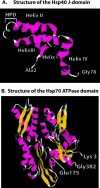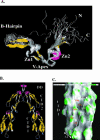Mechanisms for regulation of Hsp70 function by Hsp40
- PMID: 15115283
- PMCID: PMC514902
- DOI: 10.1379/1466-1268(2003)008<0309:mfrohf>2.0.co;2
Mechanisms for regulation of Hsp70 function by Hsp40
Abstract
The Hsp70 family members play an essential role in cellular protein metabolism by acting as polypeptide-binding and release factors that interact with nonnative regions of proteins at different stages of their life cycles. Hsp40 cochaperone proteins regulate complex formation between Hsp70 and client proteins. Herein, literature is reviewed that describes the mechanisms by which Hsp40 proteins interact with Hsp70 to specify its cellular functions.
Figures




References
-
- Banecki B, Liberek K, Wall D, Wawrzynow A, Georgopoulos C, Bertoli E, Tanfani F, Zylicz M. Structure-function analysis of the zinc finger region of the DnaJ molecular chaperone. J Biol Chem. 1996;271:14840–14848. - PubMed
-
- Bischofberger P, Han W, Feifel B, Schonfeld HJ, Christen P. d-Peptides as inhibitors of the DnaK/DnaJ/GrpE chaperone system. J Biol Chem. 2003;278:19044–19047. - PubMed
-
- Bukau B, Horwich AL. The Hsp70 and Hsp60 chaperone machines. Cell. 1998;92:351–366. - PubMed
Publication types
MeSH terms
Substances
Grants and funding
LinkOut - more resources
Full Text Sources
Other Literature Sources
